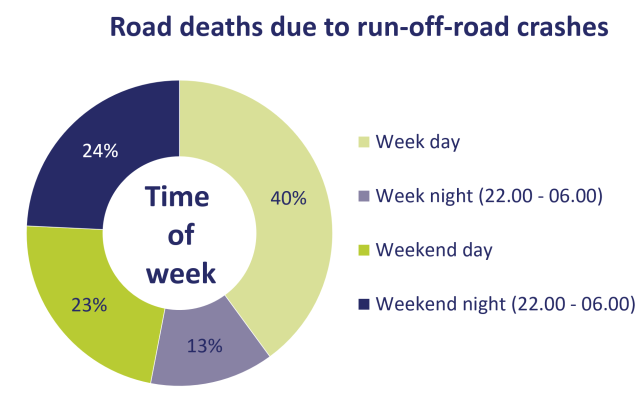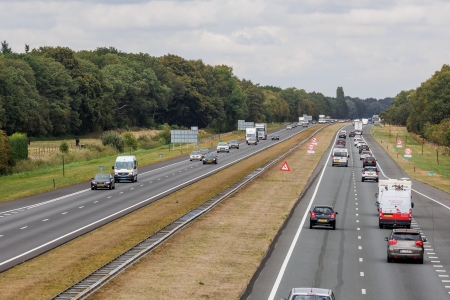Below you will find the list of references that are used in this fact sheet; all sources can be consulted or retrieved. Via Publications you can find more literature on the subject of road safety.
[1]. Schepers, P. & Klein Wolt, K. (2012). Single-bicycle crash types and characteristics. In: Cycling Research International, vol. 2, p. 119-135.
[2]. Davidse, R.J. (2011). Bermongevallen: karakteristieken, ongevalsscenario's en mogelijke interventies. Resultaten van een dieptestudie naar bermongevallen op 60-, 70-, 80- en 100km/uur-wegen [Run-off-road crashes: characteristics, crash scenarios and possible interventions. Results of an in-depth study of run-off-road crashes on 60, 70, 80 and 100 km/h roads]. R-2011-24 [Summary in English]. SWOV, Leidschendam.
[3]. Davidse, R.J., Doumen, M.J.A., Duijvenvoorde, K. van & Louwerse, W.J.R. (2011). Bermongevallen in Zeeland: karakteristieken en oplossingsrichtingen. Resultaten van een dieptestudie [Run-off-road crashes in the Province of Zeeland: characteristics and possible solutions. Results of an in-depth study]. R-2011-20 [Summary in English]. SWOV, Leidschendam.
[4]. Louwerse, W.J.R., Davidse, R.J., Sluijs, L.C. van, Duivenvoorden, C.W.A.E., et al. (2012). Over bermen, bochten en bomen: verkeerstechnische resultaten van diepteonderzoek naar bermongevallen. Paper presented at Nationaal Verkeerskunde Congres, 31 oktober 2012, Brabanthallen, ’s-Hertogenbosch.
[5]. Davidse, R.J. (2012). Diepteonderzoek naar bermongevallen: Nieuwe inzichten en aanknopingspunten voor beleid. Proceedings of the Nationaal Verkeersveiligheidscongres NVVC. Verkeersveiligheid: Een gezamenlijke verantwoordelijkheid. ANWB/SWOV/VVN, Rotterdam.
[6]. Doecke, S.D. & Woolley, J.E. (2011). Further investigation into the effective use of clear zones and barriers in a safe system's context on rural roads. Paper presented at 2011 Australasian Road Safety Research, Policing and Education Conference, 6 - 9 November 2011, Perth, Western Australia.
[7]. Jamieson, N.J., Waibl, G. & Davies, R. (2013). Use of roadside barriers versus clear zones. NZ Transport Agency research report 517. Wellington.
[8]. Petegem, J.W.H. van, Louwerse, W.J.R. & Commandeur, J.J.F. (2017). Veilige bermen langs autosnelwegen: obstakelvrije zone, geleiderails of beide. R-2017-16. SWOV, Den Haag.
[9]. Schermers, G., Petegem, J.W.H. van, Hermens, F. & Hettema, Z.J.A. (2021). Beoordeling validatie prioriteiten risicolocaties bermen. Onderzoeksverantwoording. R-2021-6A. SWOV, Den Haag.
[10]. Stipdonk, H.L., Bijleveld, F.D., Davidse, R.J., Weijermars, W.A.M., et al. (2016). De stijging in het aantal verkeersdoden op rijkswegen in 2015. Statistische analyse, bestudering van ongevallen en verkenning van mogelijke verklarende factoren [The increase in the number of road deaths on national roads in 2015. Statistical analysis, examination of crashes and exploration of possible explanatory factors]. R-2016-9 [Summary in English]. SWOV, Den Haag.
[11]. Davidse, R.J., Louwerse, W.J.R. & Duijvenvoorde, K. van (2018). Dodelijke verkeersongevallen op rijkswegen in 2016. Analyse van ongevals- en letselfactoren en daaruit volgende aanknopingspunten voor maatregelen. R-2018-9. SWOV, Den Haag.
[12]. Davidse, R.J., Louwerse, W.J.R. & Duijvenvoorde, K. van (2019). Dodelijke verkeersongevallen op rijkswegen in 2017. Analyse van ongevals- en letselfactoren en daaruit volgende aanknopingspunten voor maatregelen. R-2019-8. SWOV, Den Haag.
[13]. Davidse, R.J., Duijvenvoorde, K. van & Louwerse, W.J.R. (2020). Dodelijke verkeersongevallen op rijkswegen in 2019. Analyse van ongevals- en letselfactoren en daaruit volgende aanknopingspunten voor maatregelen [Fatal road crashes on national roads in 2019. Analysis of crash and injury factors and resulting potential countermeasures]. R-2020-29 [Summary in English]. SWOV, Den Haag.
[14]. Davidse, R.J., Duijvenvoorde, K. van & Louwerse, W.J.R. (2020). Dodelijke verkeersongevallen op rijkswegen in 2018. Analyse van ongevals- en letselfactoren en daaruit volgende aanknopingspunten voor maatregelen [Fatal road crashes on national roads in 2018. Analysis of crash and injury factors and resulting potential countermeasures]. R-2020-26[Summary in English]. SWOV, Den Haag.
[15]. Davidse, R.J., Duijvenvoorde, K. van & Louwerse, W.J.R. (2021). Dodelijke verkeersongevallen op rijkswegen in 2020. Analyse van ongevals- en letselfactoren en daaruit volgende aanknopingspunten voor maatregelen [Fatal road crashes on national roads in 2020. Analysis of crash and injury factors and resulting potential countermeasures]. R-2021-23 [Summary in English]. SWOV, Den Haag.
[16]. Davidse, R.J., Boele-Vos, M.J., Doumen, M.J.A., Duijvenvoorde, K. van, et al. (2021). Dodelijke verkeersongevallen in Noord-Brabant 2018-2019. Analyse van ongevals- en letselfactoren en daaruit volgende aanknopingspunten voor maatregelen [Fatal road crashes in the Dutch province of Noord-Brabant 2018-2019. Analysis of road crash and injury factors and resulting potential measures]. R-2021-9 [Summary in English]. SWOV, Den Haag.
[17]. Cheng, G., Cheng, R., Pei, Y. & Han, J. (2021). Research on highway roadside safety. In: Journal of Advanced Transportation, vol. 2021.
[18]. Aarts, L.T., Broek, L.J. van den, Oude Mulders, J., Decae, R.J., et al. (2022). De Staat van de Verkeersveiligheid 2022. Trend in aantal verkeersdoden en -gewonden daalt niet. R-2022-10. SWOV, Den Haag.
[19]. Hengeveld, J. & Nägele, R. (2014). De risico's van bermongevallen in samenhang met de berminrichting [confidential]. Ministerie van Infrastructuur en Milieu - Water, verkeer en leefomgeving.
[20]. Petegem, J.W.H. van, Louwerse, W.J.R. & Commandeur, J.J.F. (2017). Berminrichting langs autosnelwegen. Literatuurstudie en advies voor vergevingsgezinde bermen [Layout of roadsides along motorways. Literature study and advice for forgiving roadsides]. R-2017-16A [Summary in English]. SWOV, Den Haag.
[21]. Goldenbeld, C., Schermers, G. & Petegem, J.W.H. van (2017). Low curve radius. European Road Safety Decision Support System, developed by the H2020 project SafetyCube. Accessed on 18-10-2022 at www.roadsafety-dss.eu.
[22]. Elvik, R. (2013). International transferability of accident modification functions for horizontal curves. In: Accident Analysis & Prevention, vol. 59, p. 487-496.
[23]. Lamm, R., Psarianos, B. & Mailaender, T. (1999). Highway design and traffic safety engineering handbook. McGraw-Hill, New York.
[24]. CROW (2013). Handboek wegontwerp 2013: Gebiedsontsluitingswegen. Publicatie 330. CROW, Ede.
[25]. OECD/ITF (2015). Improving safety for motorcycle, scooter and moped riders. OECD Publishing, Paris.
[26]. Hu, W. & Donnell, E.T. (2010). Median barrier crash severity: Some new insights. In: Accident Analysis & Prevention, vol. 42, nr. 6, p. 1697-1704.
[27]. Zou, Y., Tarko, A.P., Chen, E. & Romero, M.A. (2014). Effectiveness of cable barriers, guardrails, and concrete barrier walls in reducing the risk of injury. In: Accident Analysis & Prevention, vol. 72, p. 55-65.
[28]. Nombela, M., Davila, A., Alba, J.J. & de Miguel, J.L. (2010). Innovative concepts for Smart Road Restraint Systems to provide greater safety for vulnerable users - Smart RRS. Technical paper, SAE International.
[29]. Daniello, A. & Gabler, H.C. (2011). Effect of barrier type on injury severity in motorcycle-to-barrier collisions in North Carolina, Texas, and New Jersey. In: Transportation Research Record, vol. 2262, nr. 1, p. 144-151.
[30]. Rizzi, M., Strandroth, J., Sternlund, S., Tingvall, C., et al. (2012). Motorcycle crashes into road barriers: the role of stability and different types of barriers for injury outcome. In: Proceedings of the 2012 IRCOBI Conference. Paper IRC-12-41 328-341.
[31]. Schut, M. (2021). Nog veel ongelukken door bomen in de berm. KRO-NCRV - Pointer. Accessed on 01-05-2022 at pointer.kro-ncrv.nl/nog-veel-ongelukken-door-bomen-in-de-berm.
[32]. Schermers, G. & Petegem, J.W.H. van (2013). Veiligheidseisen aan het dwarsprofiel van gebiedsontsluitingswegen met limiet 80 km/uur. Aanbevelingen voor de actualisatie van het Handboek Wegontwerp [Safety requirements for the cross sectional profile of distributor roads with an 80 km/h speed limit. Recommendations for the update of the Handbook Road Design]. D-2013-2[Summary in English]. SWOV, Leidschendam.
[33]. Weber, R., Schermers, G., Petegem, J.H. van, Cardoso, J., et al. (2019). PROGReSS (Provision of Guidelines for Road Side Safety) - Road side safety elements: state of the art report. WP 5 Quality management and final report, Deliverable 5.1. CEDR Transnational Road Research Programme: Call Safety, 2016.
[34]. CROW (2015). Richtlijnen voor de bebakening en markering van wegen. Publicatie 207. CROW, Ede.
[35]. SWOV (2002). Safety Standards for Road Design and Redesign SAFESTAR. Deliverable D9.2: final report. SWOV, Leidschendam.
[36]. Turner, S., Dixon, A. & Wood, G. (2004). Assessing the crash risk implications of roadside hazards.
[37]. Torbic, D.J., Hutton, J.M., Bokenkroger, C.D., Bauer, K.M., et al. (2009). Guidance for the design and application of shoulder and centerline rumble strips. NCHRP 641. Transportation Research Board.
[38]. Noella, K. (2017). Implementation of rumble strips at centreline. European Road Safety Decision Support System, developed by the H2020 project SafetyCube. Accessed on 20-10-2022 at www.roadsafety-dss.eu.
[39]. Vadeby, A. & Anund, A. (2017). Effectiveness and acceptability of milled rumble strips on rural two-lane roads in Sweden. In: European Transport Research Review, vol. 9, nr. 2, p. 29.
[40]. Phan, V. (2017). Electronic Stability Control (ESC). European Road Safety Decision Support System. developed by the H2020 project SafetyCube. Accessed on 03-11-2022 at www.roadsafety-dss.eu.
[41]. Høye, A. (2011). The effects of Electronic Stability Control (ESC) on crashes—An update. In: Accident Analysis & Prevention, vol. 43, nr. 3, p. 1148-1159.
[42]. Weijermars, W.A.M., Stipdonk, H.L., Dijkstra, A., Bijleveld, F.D., et al. (2018). Verkeersveiligheidsprognoses 2030. Geschat aantal verkeersdoden en ernstig verkeersgewonden zónder Strategisch Plan Verkeersveiligheid 2030. R-2018-17A. SWOV, Den Haag.
[43]. Grover, C., Avery, M. & Knight, I. (2015). Technologies for the prevention of run off road and low overlap head-on collisions. Proceedings of the 24th Enchanced Safety of Vehicles Conference. NHTSA, Gothenburg, Zweden.
[44]. Jänsch, M. (2017). Lane keeping systems. European Road Safety Decision Support System, developed by the H2020 project SafetyCube. Accessed on 11-12-2018 at www.roadsafety-dss.eu.
[45]. Katteler, H. (2003). Acceptance of Lane Departure Warning Assistance (LDWA) systems: Final report. TM-03-C022. TNO, Soesterberg.
[46]. Cleij, D. (2021). Road safety thematic report – Advanced driver assistance systems. European Road Safety Observatory, European Commission, Brussels.
[47]. EC (2021). Road safety thematic report - Fatigue. European Road Safety Observatory. European Commission, Directorate General for Transport., Brussels.
[48]. EC (2022). Road safety thematic report – Driver distraction. European Road Safety Observatory. European Commission, Directorate General for Transport, Brussels.






